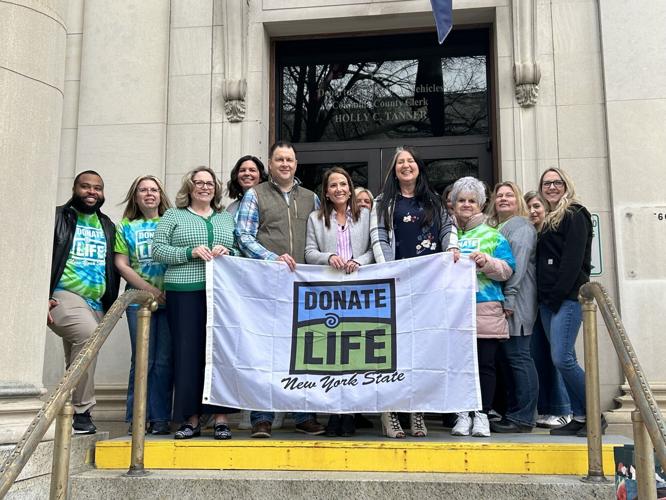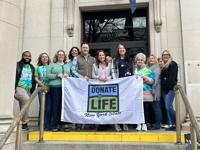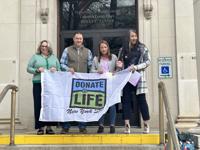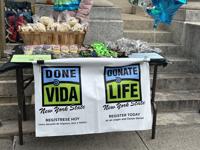HUDSON — The importance of living organ donors was the highlight of a press conference Friday at the Columbia County Department of Motor Vehicles for National Donate Life month.
Jim Horton and his wife Erica Horton, who have been married for 15 years, shared their journey with the transplant process at an event hosted by Columbia County Clerk Holly Tanner in collaboration with Donate Life New York State.
He received a kidney transplant in 2019, after his wife Erica Horton opted to be a living donor and give him one of her kidneys.
“I’ve known Erica and Jim for at least 16 years,” Tanner said. “Our sons went to school together and played baseball, and during that time frame, they started going through something really serious. It brings home the idea that organ donation isn’t just about tragedy on one end and then a happy occasion on another side, but you can also be a living donor.”
Jim Horton’s journey to getting his kidney transplant started when he was diagnosed with polycystic kidney disease, a genetic disorder that causes cysts to grow on the kidneys, and can lead to them becoming enlarged, according to the National Institute of Health.
Besides high blood pressure and the occasional burst cyst, the disorder was not a big deal for Jim Horton, 44, during his 20s and early 30s, he said.
“I just sort of lived with this and didn’t really think about it,” he said. “I didn’t require any hospitalizations in that time period, but I did see my kidney doctor, my nephrologist, a couple times a year, and I had blood work to occasionally test my kidney function.”
In 2016, when Jim Horton was 36, he said he started to feel “pretty lousy”, and after an appointment with his nephrologist they found his kidney function had gotten significantly worse.
“I was entering end-stage renal failure,” he said. “I remember my doctor telling me ‘we gotta get you a transplant, you got to get on dialysis.’”
“I said ‘OK, well how long until I have to start dialysis?’ and he sort of looked at me like ‘today’, he said ‘we’ve got to get you going like now on dialysis’, so that was pretty crazy. I always knew that was a possibility, but I didn’t really grasp it until that moment.”
Horton opted to undergo at-home dialysis, which required him to go through training to do the treatment on himself.
“I went through a couple weeks of training,” he said. “Erica came with me a lot. She had to learn with me. Everything has to be sterile and it’s quite the process. It seemed like a great idea with dialysis at home, but it was a lot.”
At-home dialysis was not simple, Erica Horton said.
“We gave it our best effort, but it was not easy, as Jim had to stay hooked up to a machine for over eight hours every night, which was not feasible with a young, active family and both of us working full-time jobs,” she said.
The couple also learned Jim Horton was prone to infections in his port site in his abdomen, which would sometimes require extended hospital stays.
They decided to have Jim Horton’s dialysis treatment performed at a dialysis center, which required a surgery to get a port inserted into his chest, and four-hour treatments three times a week.
Jim Horton’s chest port also became infected multiple times, and it was also determined he would need both of his kidneys removed because they were too big for a new kidney to be transplanted.
“That required two pretty significant surgeries,” he said. “They don’t take them both out at the same time, they take one out and you recover. They take the second one out, and that second one was delayed because I wasn’t healthy enough for that surgery due to all the infections. So, it was just a big mess all around.”
The couple was also in constant contact with the transplant team at Albany Medical Center, and friends and family were getting tested, but they were not matches, Jim Horton said.
Erica Horton was tested to see if she was a match early on, Jim Horton said.
“It was an initial match, but that was only the beginning,” he said. “She had to go through a variety of other testing, specialist visits, all that, to determine she was a total match.
“Finally we got the unbelievable, surreal news that she was the perfect candidate, and she didn’t think twice about it. She was actually excited that she could do it for me, happy to give me a kidney to save my life. I could have been on the transplant list for years, I could still be on it if Erica (Horton) didn’t give me a kidney.”
A specialist determined Erica Horton had to get a hysterectomy in order to donate to her husband, which she did not hesitate to have done, Jim Horton said.
“That was major surgery, that was in the summer of 2019,” he said. “Painful, significant recovery for that, but it was all to get to the final point of her being able to donate.”
Finally, on Oct. 8, 2019, Jim and Erica Horton underwent their separate transplant procedures.
“We kissed each other early in the morning, and made our way to separate ORs (operating rooms),” Erica Horton said. “The transplant team, led by Dr. Conti was unbelievable, and the surgery was a success.”
During the recovery process, Erica Horton’s father moved in with the family to help with their children and other tasks around the house while they recovered, and community members also donated meals to the family while they recovered.
“We had more pasta dishes than we knew what to do with,” Jim Horton said. “But within a few weeks, we were both basically as good as new.”
There have been three parts of Jim Horton’s life: before kidney failure, during kidney failure and post-transplant, he said.
“I truly have a new lease on life now,” Jim Horton said. “When we’re all healthy, it’s great, but you take it for granted when you’re healthy, I’m telling you right now. When you’re sick, chronically ill, all you want is to be healthy again. You just don’t realize that when you’re healthy, how great that is.
“Getting a transplant was a 1,000% quality of life improvement for myself, and I’ll never be able to pay that back to my wife.”
All healthy people should consider becoming a living donor, Erica Horton said.
“I forget that I gave Jim a kidney sometimes,” she said. “Really, it’s the best gift you could ever give anybody.”
There are 7,962 people waiting to receive organs in New York state, and 400 people in the state died in 2022 waiting for an organ transplant, according to Donate Life New York State.
In 2023, 46,630 people in the United States received organ transplants, with over 6,900 of those donations coming from living donors, according to United Network for Organ Sharing.
The state has come a long way in organ donation, said Aisha Tator, executive director of Donate Life New York State.
“With the help of the DMV (Department of Motor Vehicles) and the county clerks, they were responsible for 4% of our registrations,” she said. “Of the 7.6 million New Yorkers who have enrolled in the New York State Donate Life Registry, they’ve done so at the DMV and with their county clerks.”
It’s a common misconception that emergency workers and doctors will not care for people who are registered organ donors, Tator said.
“That couldn’t be further from the truth,” she said. “These are professionals who have a Hippocratic oath, their no. 1 job is to save the life of their patient. They have no idea that somebody is on the New York State Donate Life Registry, all of your personal belongings are bagged up and put away when you go into the hospital, and the database, itself, is confidential.
Only the state Department of Health, Donate Life New York State, and other authorized state and federal organizations can access the database, Tator said.
“It’s confidential, that is a common misconception and couldn’t be further from the truth,” she said. “It’s all about saving somebody’s life until that person has passed away, and it’s only after that donation is even a consideration and part of the process.”













